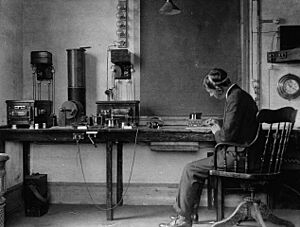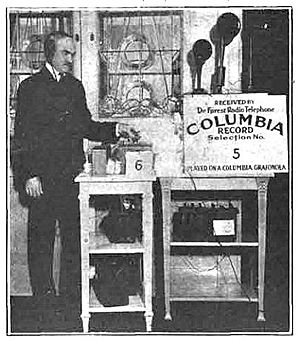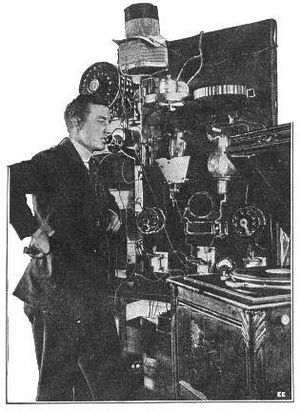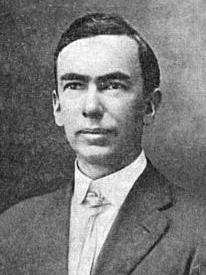History of broadcasting facts for kids
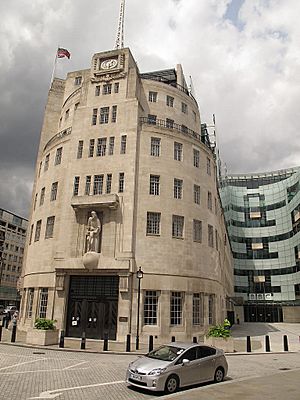
Radio broadcasting lets us send music and talk through the air to many people at once. It all started with experiments around 1905, and became popular for everyone around 1920. Before radio, some places had systems where news and music could be heard through special headsets connected to telephone lines. This was like an early form of audio streaming!
By the 1950s, almost every country had a radio system. Many were run by the government, but some, like in the United States, had commercial stations that used advertising. Later, many countries had both. A big change happened in the 1960s with small, cheap portable radios. This made it possible for almost everyone to own a radio.
Contents
Early Radio Broadcasting
Australia
Radio in Australia began with amateur radio operators in the early 1900s. In 1906, the Marconi Company made the first official Morse code transmission between two places in Australia.
First Music Broadcasts
The first time music was broadcast in Australia was on August 13, 1919. This was a demonstration by Ernest Fisk of AWA (Amalgamated Wireless Australasia). Soon, many amateur radio enthusiasts started broadcasting music regularly in 1920 and 1921. One of the first regular, non-official stations was 2CM, started by Charles MacLuran in Sydney in 1921.
Early Radio Systems
In November 1923, the government approved official radio stations. At first, they used a special "Sealed Set" system. Each radio was designed to only receive one station. Part of the radio's price helped pay the government and the radio station. This system had problems because many young people built their own radios that could get all stations.
By July 1924, this system was changed. New stations were divided into "A Class" and "B Class." A Class stations were paid for by a listener's license fee. The first five sealed set stations became A Class.
A national radio service, the Australian Broadcasting Corporation, was created in July 1932.
Mobile Radio Stations
Australia even had mobile radio stations! Two unusual stations, 2XT and 3YB, broadcast from moving vehicles. 2XT operated from a train in New South Wales from 1925 to 1927. It visited over 100 towns. 3YB offered a similar service in Victoria from 1931 to 1935, first from a car and truck, then from a converted train carriage. These mobile stations helped sell radios and brought entertainment to rural areas.
There was even a ship, the MV Kanimbla, built in 1936 with its own broadcasting station, 9MI. It broadcast on short wave from the sea, and its programs were sometimes shared with other stations.
Canada
Radio in Canada started early, with experimental broadcasts in Montreal in 1919. Canadians quickly became interested, building their own radios to listen to stations. The Marconi Company in Canada sold its first commercial radio in 1921.
Early history of Canadian radio includes how the technology grew, how stations and networks were built, and how people bought and used radios. There were also discussions about whether stations should be owned by the government or by private companies. People wondered how radio would affect Canadian identity and culture, especially with many American stations being easily heard in Canada.
The first Canadian station was CFCF, which started as an experimental station (XWA) by the Marconi Company in Montreal on December 1, 1919. It began regular programs in May 1920. Other early stations included CKCE (later CFCA) in Toronto, started by the Toronto Star newspaper in 1922, and CKAC in Montreal, started by La Presse newspaper. Because there were limited radio frequencies, CKAC and CFCF sometimes had to take turns broadcasting.
As radio grew, American stations often dominated the airwaves in Canada. In 1928, Canada got its first radio network, run by the Canadian National Railways (CNR). CNR had been involved in radio since 1923, even putting radio receivers on its trains for passengers to enjoy.
Cuba
People in Cuba were interested in radio from the very beginning, often listening to American stations from Florida. The first radio station in Cuba, PWX, started in Havana on October 10, 1922. It was a joint project and broadcast programs in both English and Spanish. Its signal was strong enough to be heard in some American cities at night. By 1932, Cuba had over thirty radio stations across the island.
France
Radio stations like Radio Paris, Radio Toulouse, and Radio Lyon began operating in France in 1922. Before 1940, France had 14 commercial and 12 public radio stations. The government controlled radio broadcasting very strictly. For example, political debates were not encouraged, and news broadcasts were very short and supervised by the Prime Minister's office. This meant French citizens often didn't know much about important events leading up to World War II from their radios.
Germany
The first public radio broadcast in Germany was a Christmas concert on December 22, 1920. The first official radio station in Germany, "LP," started in Berlin in late 1923. Before 1933, ten regional broadcasting groups ran German radio, with government oversight. Listeners paid a fee for their radios.
After 1933, Joseph Goebbels took full control of broadcasting for the Nazi government. Non-Nazis and Jewish people were removed from radio jobs. The Nazis made it illegal for Germans to listen to foreign broadcasts. During World War II, German stations broadcast war messages and entertainment, and also used short wave radio to send propaganda to other countries.
Japan
Japan's first radio station, JOAK, opened in Tokyo in March 1925. It was unique because one of its announcers was a woman, Akiko Midorikawa. Soon after, JOBK in Osaka and JOCK in Nagoya opened. The National Broadcasting Service, now known as NHK, began in August 1926. All stations were supported by licensing fees paid by people who owned radios. Early Japanese radio programs included music, news, language lessons (English, French, German), and educational talks. Stations broadcast about eight hours a day.
Mexico
Amateur radio was very popular in Mexico. The first commercial radio station, CYL, started in Mexico City in November 1923. It played music, religious services, and news. CYL gained government approval by allowing political candidates to use the station for their campaigns. Its signal was so strong it could sometimes be heard in Canada. By 1932, Mexico had nearly forty radio stations.
Philippines
Radio stations were operating in the Philippines as early as 1922. In 1927, KZRM in Manila, owned by the Radio Corporation of the Philippines, began broadcasting. By 1932, the island had three stations: KRZC in Cebu, and KZIB and KZFM in Manila. KZFM, the government-owned station, was the strongest. Later, two radio networks were created: the Manila Broadcasting Company and the Philippine Broadcasting Company. These stations also worked with American networks to share popular programs.
Sri Lanka
Sri Lanka has one of the oldest radio stations in Asia, called Radio Ceylon, now known as the Sri Lanka Broadcasting Corporation. Broadcasting began experimentally in Ceylon in 1923, just three years after it started in Europe. Music was broadcast from a small room using a transmitter built from equipment from a captured German submarine.
United Kingdom
The first experimental music broadcasts in the UK started in 1920 from Marconi's factory in Chelmsford, England. In October 1922, a group of radio makers formed the British Broadcasting Company (BBC). They allowed some sponsored programs. The first stations were 2MT near Chelmsford and 2LO in London, both run by the Marconi Company. By late 1923, there were six regular stations in the UK.
In 1926, the British Broadcasting Company became the British Broadcasting Corporation, a non-commercial organization. Its leaders are chosen by the British government, but they work independently. Lord Reith played a key role in shaping the BBC, especially in radio.
United States
Reginald Fessenden did important experiments with voice and music broadcasts by 1906. Charles "Doc" Herrold in San Jose, California, started broadcasting as early as April 1909. He used the phrase San Jose Calling. He was on the air daily for almost ten years before World War I stopped operations.
Pioneer station 2XG in New York City was the first to use a special vacuum tube transmitter for regular broadcasts. Charles Herrold used an arc transmitter for his broadcasts from 1912 to 1917. He also created the terms "broadcasting" (sending to a wide audience) and "narrowcasting" (sending to a smaller, specific audience).
After World War I, radio pioneers started broadcasting again. Early stations like 8MK (later WWJ in Detroit) were started by newspapers. Another early station, 8XK in Pittsburgh, became KDKA in 1920.
Advertising quickly became the main way most radio stations in the United States made money. The U.S. never had a fee for radio owners.
Radio also became important for education. In April 1922, WGI Radio broadcast educational talks from Tufts College professors, like a "wireless college." Many other colleges soon added radio courses.
By 1931, most U.S. homes had at least one radio. In 1934, several stations formed the Mutual Broadcasting System to share popular programs like The Lone Ranger. The Federal Radio Commission (FRC) was created in 1927 to supervise radio, and in 1934, it became the Federal Communications Commission (FCC). This agency helped shape how radio and later television would operate.
Radio in the 1950s and 1960s
Australia
Norman Banks was a very famous radio host in Melbourne, Australia. He worked at stations like 3KZ and 3AW for many years. He is known for starting "Carols by Candlelight," being a pioneer in football commentary, and hosting music and interview shows. Later, he became one of Melbourne's first and most well-known "talk back" radio hosts, where listeners could call in.
The transistor radio came out in 1954. These small, cheap, and portable radios made it possible for people to have a radio in every room, in their car, or even in their pocket. This led to stations starting to focus on specific types of listeners. For example, some stations focused on news, while others played pop music for younger audiences. "Talk back" radio became very popular by the late 1960s.
Germany
When West Germany was formed in 1949, broadcasting was organized by each state, not by the national government. Nine regional radio networks were set up. The U.S. American Forces Network (AFN) also had its own radio stations for Allied forces in Europe. Inside Berlin, Radio in the American Sector (RIAS) was a key source of news for people in East Germany.
Sri Lanka
Radio Ceylon was very popular in the 1950s and 1960s, especially in India. It became the most listened-to radio network in South Asia. Many famous announcers worked there, and its Hindi service helped it gain a huge fanbase among Hindi speakers. The Commercial Service of Radio Ceylon was very successful under the leadership of Clifford Dodd, an Australian broadcasting expert.
United States
By 1955, most U.S. homes had at least one television set, which started to change how people got their entertainment and news.
Radio in the 1970s, 1980s, and 1990s
Australia

Europe
Commercial radio became legal again in most European countries during this time, starting with the United Kingdom in 1973 and ending with Austria in 1995. In 1987, stations in the European Broadcasting Union began offering Radio Data System (RDS). This system provides text information about programs, traffic alerts, and accurate time on your radio display.
The 2000s
Australia
In Australia, digital radio was introduced gradually starting in August 2009. Today, many radio stations are available on the internet and also have digital versions. By 2007, Australia had 261 commercial radio stations.
Sri Lanka
In 2005, celebrating 80 years of broadcasting history, leaders in Sri Lanka called for Radio Ceylon (now Sri Lanka Broadcasting Corporation) to use new digital technologies and preserve its old radio recordings.
See also
- AM broadcasting#History
- FM broadcasting#History
- Oldest radio station
- Oldest television station
- Women in early radio
- History of advertising
- History of radio
- History of journalism
- Timeline of radio
- Timeline of the introduction of radio in countries
- Radio broadcasting
- History of podcasting
- History of telecommunication
- History of television



